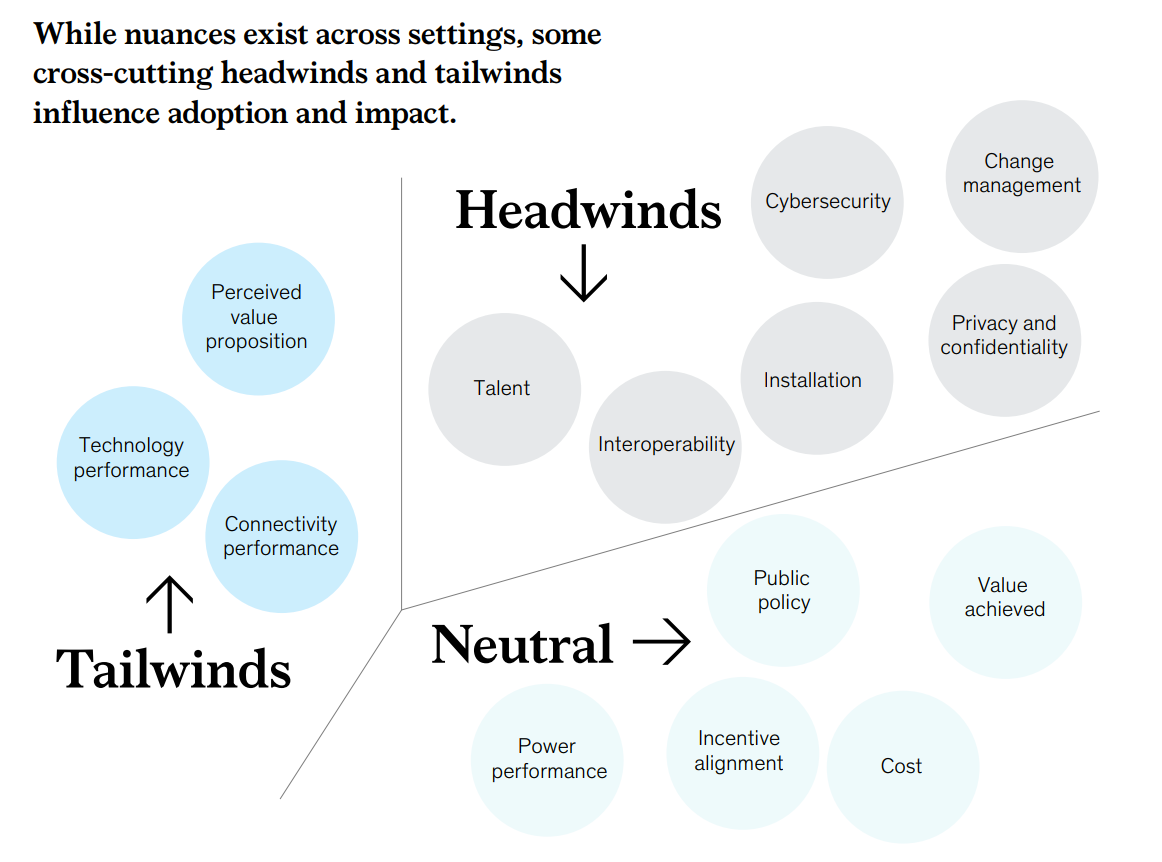(Editor’s Note: This article, excerpted and translated from ulinkmedia. )
In its latest report, “The Internet of Things: Capturing accelerating Opportunities,” McKinsey updated its understanding of the market and acknowledged that despite rapid growth over the past few years, the market has failed to meet its 2015 growth forecasts. Nowadays, the application of the Internet of Things in enterprises faces challenges from management, cost, talent, network security and other factors.
McKinsey’s report is careful to define the Internet of Things as a network of sensors and actuators connected to computing systems that can monitor or manage the health and health of connected objects and machines. Connected sensors can also monitor the natural world, human and animal behavior.
In this definition, McKinsey excludes a broad category of systems in which all sensors are primarily intended to receive human input (such as smartphones and PCS).
So what’s next for the Internet of Things? McKinsey believes that the trajectory of iot development, as well as the internal and external environment, has changed dramatically since 2015, so it analyzes tailwind and headwind factors in detail and provides development recommendations.
There are three main tailwinds that are driving a substantial acceleration in the iot market:
- Value Perception: Clients who have done iot projects are increasingly seeing application value, which is a substantial improvement over McKinsey’s 2015 study.
- Technological Progress: Due to technological evolution, technology is no longer a bottleneck for large-scale deployment of iot systems. Faster computing, lower storage costs, improved battery life, advances in machine learning… Are driving the Internet of things.
- Network effects: From 4G to 5G, the number of connected devices has exploded, and the speed, capacity, and latency of various network protocols have all increased.
There are five headwind factors, which are the challenges and problems that the development of the Internet of Things generally needs to face.
- Management Perception: Companies generally view the Internet of Things as a technology rather than a change in their business model. Therefore, if an iot project is led by the IT department, IT is difficult to generate the necessary changes in behavior, process, management, and operations.
- Interoperability: The Internet of Things is not everywhere, all the time, it has a long way to go, but there are many “smokestack” ecosystems in the iot market right now.
- Installation Costs: Most enterprise users and consumers view the installation of iot solutions as one of the biggest cost issues. This is related to the previous headwind, interoperability, which does increase the difficulty of installation.
- Cyber Security: More and more governments, enterprises and users are paying attention to the security of the Internet of Things, and the nodes of the Internet of Things around the world provide more opportunities for hackers.
- Data Privacy: With the strengthening of data protection laws in various countries, privacy has become a top concern for many enterprises and consumers.
In the face of headwinds and tailwinds, McKinsey offers seven steps for successful large-scale deployment of iot projects:
- Define the decision-making chain and decision-makers of Internet of Things projects. At present, many enterprises do not have clear decision-makers for iot projects, and the decision-making power is scattered in various functions and business departments. Clear decision makers are key to the success of iot projects.
- Think scale from the start. Many times, companies are attracted by some new technology and focus on the pilot, which ends up in the “pilot purgatory” of continuous pilot.
- Have the courage to bend into the game. Without a silver bullet — that is, no single technology or approach that can be disruptive — deploying and applying multiple iot solutions at the same time makes it easier to force companies to transform their business models and workflows to capture more value.
- Invest in technical talent. The key to solving the shortage of technical talent for the Internet of Things is not candidates, but recruiters who speak technical language and have technical business skills. While data engineers and chief scientists are critical, the advancement of organizational capabilities depends on continuous improvement of data literacy across the board.
- Redesign core business models and processes. The implementation of Internet of Things projects is not just for IT departments. Technology alone cannot unlock the potential and create value of Internet of Things. Only by redesigning the operation model and process of business can digital reform have an effect.
- Promote interoperability. The current iot landscape, dominated by fragmented, dedicated, vlocation-driven ecosystems, limits the iot’s ability to scale and integrate, hinders iot deployment and drives up costs. Enterprise users can use interoperability as a procurement criterion to promote the interconnection of iot systems and platforms to some extent.Promote interoperability. The current iot landscape, dominated by fragmented, dedicated, vlocation-driven ecosystems, limits the iot’s ability to scale and integrate, hinders iot deployment and drives up costs. Enterprise users can use interoperability as a procurement criterion to promote the interconnection of iot systems and platforms to some extent.
- Proactively shape the corporate environment. Enterprises should strive to build their own iot ecology. For example, we should give priority to network security from day one, select reliable suppliers, and build a network security risk management framework from two aspects of technical solutions and corporate governance to ensure end-to-end Internet of Things security.
Overall, McKinsey believes the Internet of Things, while growing more slowly than expected, will still create significant economic and social value. The factors that slow and hinder the development of the Internet of Things are not the technology itself or lack of confidence, but operational and ecological problems. Whether the next step of iot development can be pushed forward as scheduled depends on how iot enterprises and users address these adverse factors.
Post time: Nov-22-2021

